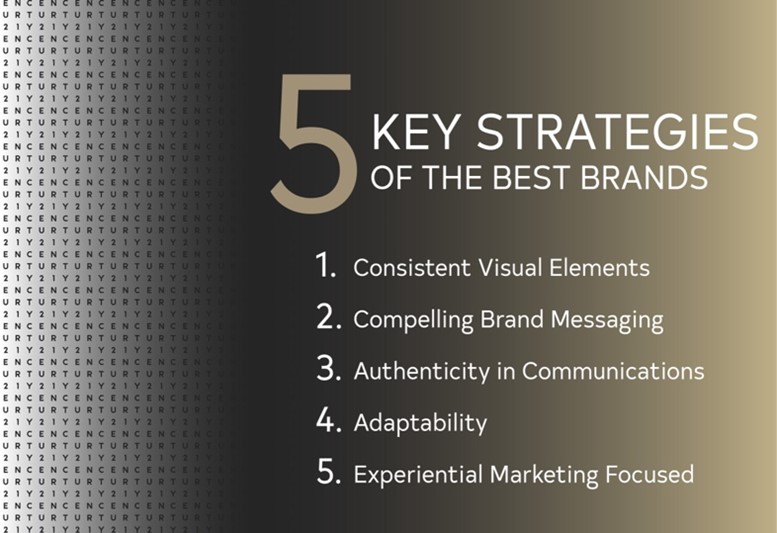What Makes a Brand Popular?
Ever find yourself marveling at how certain brands just stick with you? Well, it’s not pure magic; it’s strategic. In this week’s blog, we’re diving into what makes popular brands not just stand out but practically steal the show.
What You Need to Know:
- Consistent Visual Elements
- Compelling Brand Messaging
- Authenticity in Communications
- Adaptability
- Experiential Marketing Focused
1. Consistent Visual Elements:
According to HubSpot, the way consumers interpret your brand has a lot to do with color psychology:
- Approximately 90% of a consumers first impression is based on the brand’s primary color.
- Choice of color can influence awareness and recognition of your brand by as much as 80%
- 93% of consumers report making purchases based on visuals alone.
Logo Love: Think about Apple’s iconic bitten apple or Nike’s swoosh – these symbols practically shout the brand’s identity. What symbols come to mind when you think of your favorite brands, like the distinctive McDonald’s golden arches or Starbucks’ iconic mermaid?
- McDonald’s Golden Arches: The arches represent more than fast food; they symbolize a welcoming destination. How has this iconic logo influenced your perception of the brand?
- Starbucks Mermaid: The siren in the Starbucks logo has evolved over the years. What nuances do you notice in this evolution, and how does it align with the brand’s journey?

Color Vibes: Colors are the silent storytellers of branding. Think about Coca-Cola’s bold red or the soothing green of Starbucks. What emotions do these colors evoke, and how do they contribute to the overall brand experience?
- Coca-Cola’s Red: The vibrant red is associated with energy and excitement. How does this color choice reflect Coca-Cola’s brand personality, and how does it impact your emotional connection with the product?
- Starbucks’ Green: The calming green of Starbucks might evoke feelings of relaxation. How does this color choice align with the brand’s positioning as a cozy and comfortable coffee haven?

2. Compelling Brand Messaging:
Taglines and Slogans: What’s the difference? More than you think! According to HubSpot, “A slogan encompasses a company’s mission, what it stands for, and even how it’s helping customers in the individual campaigns the company might run. Slogans can therefore be longer than taglines.”
On the other hand, taglines are often shorter phrases that help immediately illicit a brand in the consumer’s mind. Consider the following, “I’m lovin’ it” – McDonald’s isn’t just selling burgers; they’re selling an experience. Think of Nike’s empowering “Just Do It” or the timeless “Have a break, have a Kit Kat.”

Storytime: Brands like Patagonia and TOMS weave stories that go beyond products. Patagonia’s commitment to environmental activism and TOMS’ one-for-one model tell a story that resonates. What brand stories align
with your values?
3. Authenticity in Communication:
Social Media Realness: Take a moment to appreciate Wendy’s Twitter sass. Which brands in your social media feed feel like real people?
- Wendy’s Twitter Sass: Wendy’s is known for its witty and sometimes sassy Twitter interactions. How does Wendy’s unique social media presence set it apart from other brands, and does it make you more inclined to engage with their content?
- Honest Marketing: Dove’s “Real Beauty” campaign and Ben & Jerry’s commitment to fair trade – these transparent marketing efforts build trust. Can you think of other brands that lay it all out on the table, and how does that impact your loyalty?
4. Adaptable Brand Evolution:
Rebranding Tales: Google’s transformation from a playful logo to a sleeker, more modern design or Airbnb’s shift to a symbol of belonging – how do you feel about brands evolving over time? Consider the evolution of Pepsi’s logo or the redesign of the Instagram icon.
Digital Charm: Responsive design is key. How does a seamless online experience, like that of Amazon or Netflix, influence your perception of a brand?
5. Experiential Marketing:
Property Adventures: Real estate brands using VR and AR for immersive property tours – imagine virtually walking through your dream house with Zillow or Realtor.com. How do these experiences influence your perception when making significant decisions?
Interactive Showcases: What features would you want to virtually explore in your dream neighborhood? Imagine engaging with an interactive online showcase from a real estate brand. How might that impact your decision to move?
Wrapping It Up
Unveiling the strategies behind brand identity reveals a fascinating world of connection and emotion. Now, reflect on your favorite brands. Is it the symbolism, the color palette, the stories, or the seamless online experience that draws you in? It’s not just about buying a product or a house; it’s about building a connection that lasts.


 Facebook
Facebook
 X
X
 Pinterest
Pinterest
 Copy Link
Copy Link



